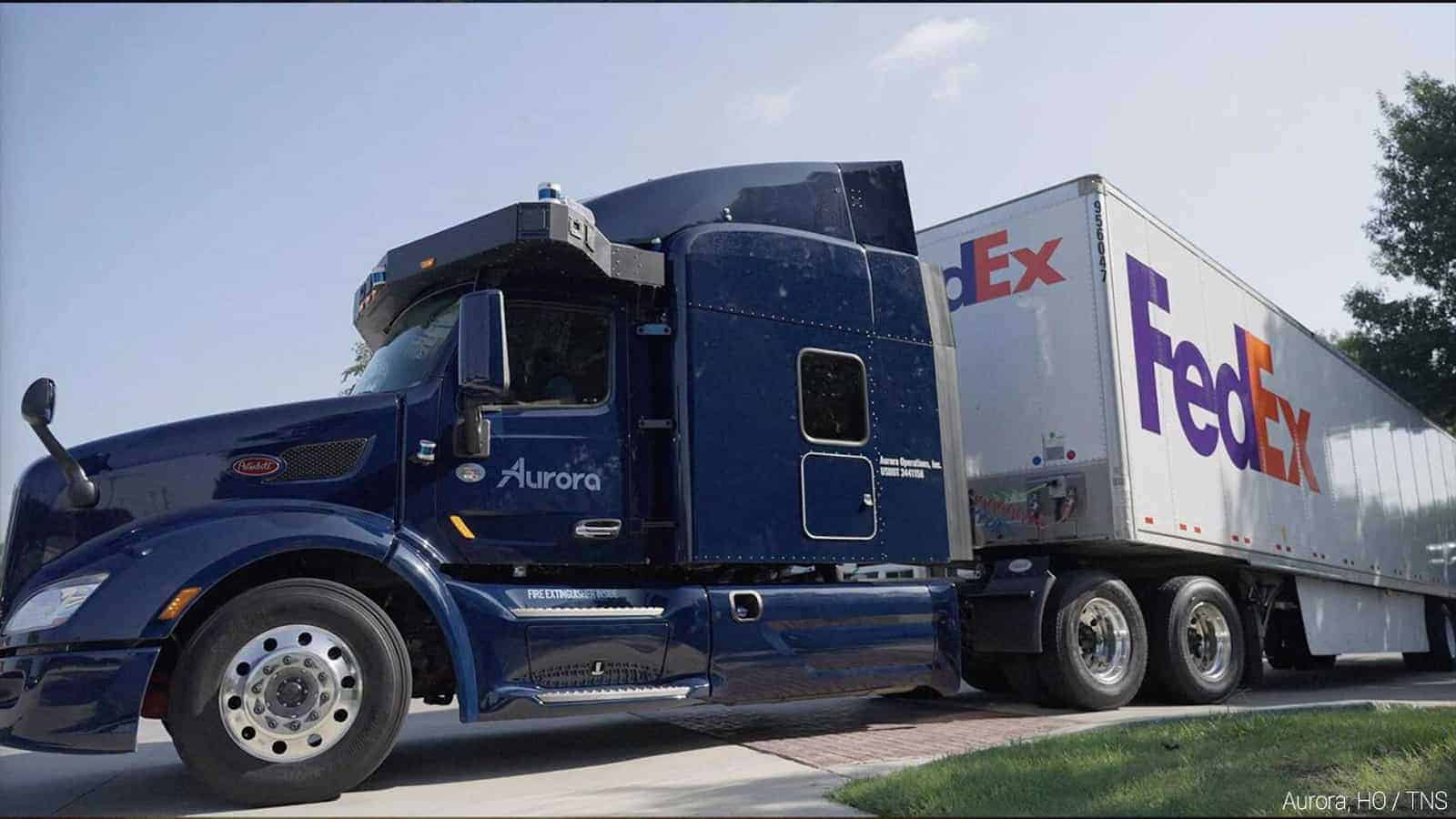Last month, FedEx used autonomous trucks on a delivery route in Texas for the first time. Self-driving technology powered the 18-wheeler, but a safety driver also went on the delivery for backup. FedEx says it will start making regular deliveries in Texas using the “driverless” trucks powered by self-driving company Aurora.
The big rig drove along the heavily traveled Interstate 45 for 500 miles between Dallas and Houston. This delivery was part of a pilot program between Aurora and truck manufacturer PACCAR. The trucks equipped with self-driving technology will complete deliveries multiple times a week along this route. A backup safety driver will go along for the ride until the end of 2023.
At that time, Aurora hopes to launch its autonomous trucking business to deliver shipments between facilities without a safety driver. The pilot program will only include a small number of trucks to assess any problems. As they refine the technology, Aurora will keep adding to the fleet on the Dallas-to-Houston route.
How FedEx will put self-driving technology to work
Aurora and Paccar will use Kenworth and Peterbilt trucks, specifically, to launch their autonomous truck program. This innovation comes at an opportune time for FedEx while they experience record delivery volumes. With the busy holiday season fast approaching, getting more trucks on the road is of utmost importance.
Inside the truck, Aurora’s autonomous technology includes a screen showing views from cameras placed around the vehicles. It also comes with LiDAR, radar, sensors, and additional software. All of this technology allows a computer to control the truck. Finally, the self-driving trucks have a Plan B for crucial systems like steering, braking, and power supply in case the driverless technology malfunctions.
Aurora has also partnered with other companies like Volvo to create self-driving Class 8 trucks at scale. By 2023, the company hopes to start selling its driverless trucks in select states. Testing without safety drivers will begin before then.
Driverless won’t replace all actual drivers, so don’t worry.
Many people wonder about the future of self-driving personal vehicles. However, Paccar chief technology officer John Rich says that driverless technology works better in long-distance trucks. With passenger cars driving in congested cities, there’s more room for error than on open free. That’s not to say companies will not develop the technology, but more challenges exist for passenger cars than long-haul trucks.
With the advent of driverless technology, many truckers fear that they will lose their jobs. However, Rebecca Yeung, vice president of innovation and advanced technology at FedEx, said the company would only use driverless trucks for routes outsourced to third parties. When the company experiences a surge in business, they often outsource routes to third parties to meet demand.
So, truckers who operate under won’t have to worry about losing their job to technology. Yeung added that the company views drivers as assets, and the driverless technology won’t displace them. Drivers also supervise the loading and unloading of freight, log inventory and even help with bookkeeping, making them invaluable.
However, as an industry leader, FedEx wants to stay ahead of the game regarding technology. The company embraces artificial intelligence, robots, driverless vehicles, and other emerging technologies to enhance its business.
FedEx CEO and chairman, Fred Smith, said:
“The world turns on innovation. FedEx is intent on innovating for good. We believe we’re responsible for creating not only business value for our stakeholders but societal value for our world. Probably one of the biggest tech trends in the news today is autonomous vehicles, a combination of big data and AI. It’s an important area in terms of safety since 90% of all accidents are caused by human error.”
Besides self-driving delivery trucks, here are other technologies FedEx will employ in their business
Here are some other new ideas FedEx will try:
An AI app to initiate shipments:
FedEx says that one day, they envision shipments being ordered through Amazon Echo or Google Home. The AI-enabled Alexa app currently being developed by FedEx will eventually understand commands “like “Prepare a shipment.” This streamlined process will eliminate tedious, time-consuming tasks like filling out forms. Then, a truck will pull up to your front door and pick up the shipments.
One driver controlling a convoy of trucks:
FedEx partnered with Peloton Technology to develop “vehicle platooning.” This pioneering technology involves electronically linking trucks into small groups called “platoons.” Using wireless vehicle-to-vehicle communication, the lead truck driver controls the speed of the trucks behind him. The technology will decrease wind resistance, therefore saving fuel.
Robotic members of staff:
FedEx already employed their first robotic staff member, Sam, at their New York office. A customer gave Sam her broken smartphone, and Sam delivered it to an employee in the back office. Sam then completed the transaction. Smith says to expect more robotic assistants in the future; others working there include Lil’ Rico, Falcon, and even one named Area 51.
Courier robots:
One day, you might see a robot rolling up to your front door with a FedEx package. Since they can carry heavy loads and travel farther than drones, robots may become the way of the future. In fact, FedEx has already tested this technology with the company Nuro. The autonomous delivery vehicles have been deployed in Memphis, Tennessee, and Plano and Frisco, Texas, and Manchester, New Hampshire, so far. Using the bots, retailers can accept orders from nearby customers and deliver them on the same day.
Final Thoughts: FedEx launches self-driving delivery trucks in Texas
Technology is changing our world faster than ever before. FedEx recently launched its first driverless delivery trucks between Dallas and Houston, Texas. The company partnered with autonomous technology leader Aurora along with truck manufacturer PACCAR. The trucks will travel along I-45 in Texas multiple times a week to complete deliveries.
Eventually, the trucks will be completely driverless, but a safety driver tags along for backup for now. When the pilot program is complete in 2023, Aurora hopes to sell its autonomous trucks in select states. At that time, FedEx will also expand its driverless fleet in Texas. So, if you see a giant 18-wheeler without a driver one day, don’t worry–the computers know what they’re doing.















